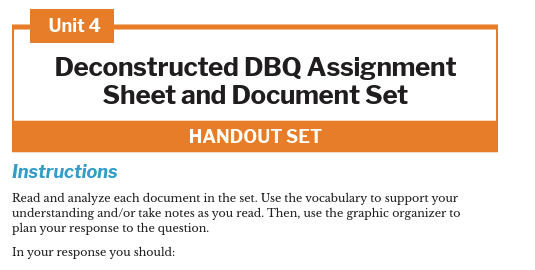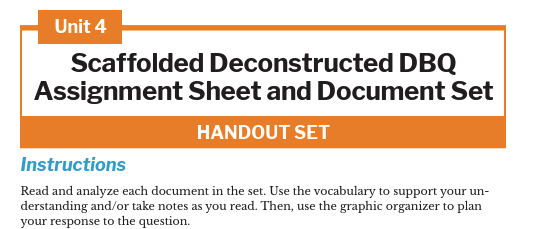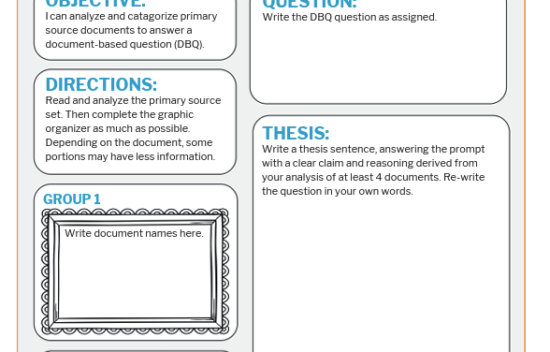
Unit 4 Civic and Constitutional Life Deconstructed DBQ
Lesson Components
Guiding Question
- How can understanding the principles of the Constitution help citizens participate effectively in a democratic society?
Objectives
- Students will engage in critical thinking to interpret historical perspectives using VIEW (Voice, Intent, Environment, Who).
- Students will practice document analysis skills through a Silent Discussion activity.
- Students will develop a thesis statement using historical evidence.
- Students will group sources based on similarities and historical themes.
- Students will develop a thesis that answers the guiding question using evidence from grouped sources.
Student Materials
- Document Set (choose 1)
- Deconstructed DBQ Assignment Sheet and Document Set
- Scaffolded Deconstructed DBQ Assignment Sheet and Document Set
- Documents contained within both sets include:
- Document A: Excerpt from the Preamble of U.S. Constitution (1787)
- Document B: Excerpt from First Amendment (1787)
- Document C: Excerpt from Tenth Amendment (1787)
- Document D: Excerpt from Federalist #51, James Madison (1788)
- Document E: Miranda v. Arizona (1966) – U.S. Supreme Court Decision
- Document F: Engel v. Vitale (1962) – U.S. Supreme Court Decision
- Documents contained within both sets include:
- Unit 4 Thesis, Grouping, and “VIEW” Deconstructed DBQ Graphic Organizer
Teacher Materials
- Chart paper and markers (for Silent Discussion)
- Unit 4 Slide Deck
- Unit 4 Model Organizer and Scoring Guide Teacher Resource
- Unit 4 Deconstructed DBQ Document Set and Teacher Context Teacher Resource
Facilitation Notes
- This is a mini-lesson intended to take 45-60 minutes and focus on a specific skill. It was created to accompany the mini-lesson teacher slide deck.
- This lesson is created to build upon the previous Deconstructed DBQ lessons. However, it can be implemented in isolation with additional supports. Modify using the scaffolding notes to fit your classroom.
- The goal is to help students develop the skill of analyzing primary sources using the VIEW framework (Voice, Intent, Environment, Who), group sources based on similar characteristics and create thesis statements.
- Common acronyms for primary source analysis include HIPP or HAPPY, but this lesson uses VIEW to structure analysis and writing.
Engage
Hook Question
- Write on the board:
- What are some key principles in the U.S. Constitution?
- Ask students to brainstorm answers aloud (for example: separation of powers, checks and balances). Record key responses on the board.
Scaffolding note: If students struggle to provide responses, provide them with a copy or project BRI’s Founding Principles Handout.
Introduce the Deconstructed DBQ
- Tell students: “Today we will investigate how these principles not only inform government, but how they can help everyday citizens like you and me participate in democratic society effectively. We will be using several primary source documents to help us answer the question.”
- Distribute the deconstructed DBQ document set and allow students 3-5 minutes to skim them and ask any questions they may have.
Scaffolding note: There are 6 documents in this primary source set. Scale the set to fit the needs of your students if needed. 3-4 documents is a good place to start.
Teacher note: There are slides in the teacher deck to facilitate a whole-group discussion or reading if your students need more support.
Explore
Document Analysis Using VIEW
- Use the review slides if needed to refresh students on the purpose of document analysis, provide thought prompts, and preview the organizer.
- Students independently analyze the documents using the VIEW framework:
- Voice – Who created the source?
- Intent – Why was the source created?
- Environment – What was happening when the source was created?
- Who – Who was the intended audience?
- Students record their findings in the VIEW Graphic Organizer.
Silent Discussion
- Transition: Group students into pairs or small groups (2-3 students).
- Overview the rules of silent discussion and view the example available in the slide deck.
- Assign each group a piece of chart paper with one of two guiding questions:
- What constitutional principles are reflected in the Constitution?
- How can citizens participate in Democracy?
- Students respond silently using markers to the question and each other:
- Add a question mark (if confused or need clarification).
- Draw a line (if connecting ideas).
- Add a checkmark (if they agree).
- After 3 minutes, rotate the chart paper to the next group (or the group to the next chart paper) and repeat.
- This time students will respond to the question, their other group members, and the writing left by the last group.
- After two rotations, return to the original chart and have students briefly discuss aloud what they noticed.
Grouping Sources
- Transition: Students return to their independent work area.
- Students group documents based on shared themes, common attributes, constitutional principles (e.g., separation of powers, individual rights), or any other categories they decide.
- Encourage students to justify their groupings in writing using evidence from the documents.
- Sample groupings:
- Checks and balances → Federalist #51, Preamble
- Individual rights → First Amendment, Miranda v. Arizona
- Federalism → Tenth Amendment, Engel v. Vitale
Teacher note: Additional support for this skill and an example is available in the teacher slide deck.
Thesis Writing & Organizer Completion
- Students use their grouped sources to draft a thesis that answers the guiding question.
- Example structure:
- Understanding constitutional principles like [principle 1] and [principle 2] helps citizens participate by [action 1] and [action 2].
- Example:
- Understanding the principles of checks and balances and popular sovereignty helps citizens participate by holding leaders accountable and influencing government decisions.
- Students write their thesis on the graphic organizer and complete any remaining sections of the Deconstructed DBQ organizer.
Teacher note: Review and example slides are available in the teacher slide deck on hidden slides if re-teaching or specific skill instruction is needed. There are also additional thesis examples in the notes of the slides.
Scaffolding note: Students needing more of a challenge could be given the opportunity to turn their Deconstructed DBQ into a written response at this stage. This could be a paragraph, or multiple paragraph essay depending on the amount of challenge needed.
Assess (5 minutes)
- Students complete their graphic organizer and submit for assessment.
- Collect organizers to assess whether students:
- Accurately analyzed sources using VIEW.
- Grouped sources based on logical connections.
- Created a clear, defensible thesis.
Reflect
Peer Review
- Have students share their organizer with a partner.
- Using the prompts from the slide deck, ask students to review their partner’s organizer.
- Ask students to focus on one aspect or review all three depending on your time.
Scaffolding note: The peer review could be completed before students submit their graphic organizers for assessment for a formative assessment.
- Optional Debrief Questions:
- How did analyzing the sources help shape your thesis?
- What challenges did you face when grouping the sources?


